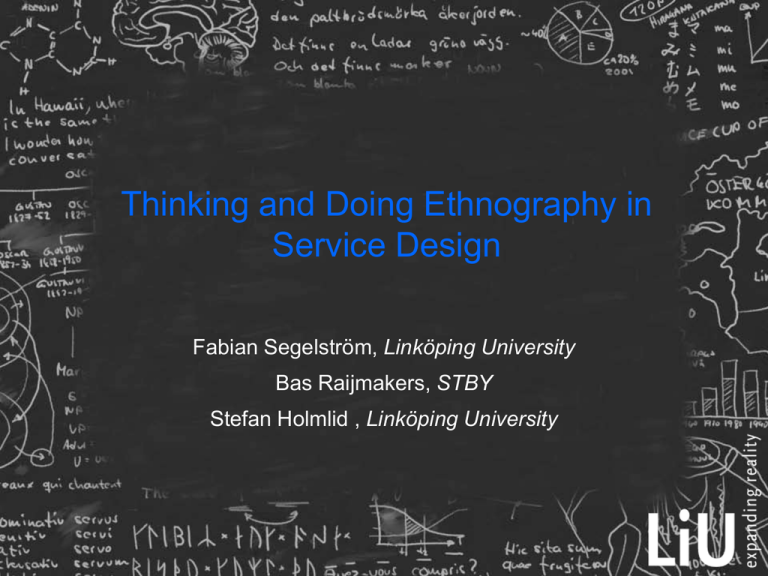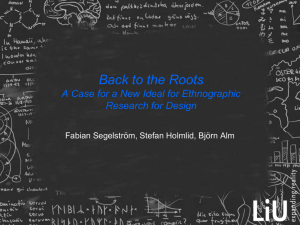Thinking and Doing Ethnography in Service Design Linköping University STBY
advertisement

Thinking and Doing Ethnography in Service Design Fabian Segelström, Linköping University Bas Raijmakers, STBY Stefan Holmlid , Linköping University HUMAN-CENTERED SYSTEMS Fabian Segelström Appropriating Ethnography to Service Design The ethnographic approach needs to be appropriated when used in a Service Design context Appropriated in relation to the origins in Anthropology Exemplified through two case studies Rigour = To be able to perform studies at a level in which the methodological choices are clear as well as acceptable to outside observers HUMAN-CENTERED SYSTEMS Fabian Segelström Ethnography Originated in Anthropology First fieldwork done 1898 Malinowski revolutionized the field Chicago-school started to use of ethnography in Sociology Sociology used ethnography at home instead of remote countries as Anthropology had done Suchman was one of the first to do Design Ethnography Has been a part of Service Design since the early days of the discipline HUMAN-CENTERED SYSTEMS Fabian Segelström Malinowski’s standards Live with the studied objects to be able to study all aspects of life for an extended period of time Be able to speak the local language Participant observation: Do what the studied objects do as well to the best of your ability, whilst observing them HUMAN-CENTERED SYSTEMS Fabian Segelström Case studies Walking quiz: Sweden Study in worn-down neighbourhood with many elderly inhabitants Access to large group of inhabitants through a social club with elderly members Friction: Limited time with informants and all at once Co-creative workshops: UK Regeneration project built on a community-led vision to transform Cornwall’s most derelict urban area and the oldest UK tin mine into an inspirational cultural landscape Friction: To perform ethnography for built environments that have not been built yet HUMAN-CENTERED SYSTEMS Fabian Segelström Walking Quiz Well known activity, often held in connection to club activities and social gatherings The goal is to answer a number of questions along a set path Questions always have three alternatives The Walking Quiz was used as a quantitative survey on attitudes surrounding living in the neighbourhood Example: ” Do you feel safe enough in the neighbourhood?” The quantitative part yielded very high response rate ≈ 76% To gather qualitative data as well, the design team took on various roles during the Walking Quiz Follow-up interviews after the Walking Quiz had been finished Contextual interviews as the question’s were answered HUMAN-CENTERED SYSTEMS Fabian Segelström Walking Quiz & appropriations A way of interacting with a larger number of informants in a limited time than would have been feasible otherwise The Walking Quiz was performed in a familiar context and situation for the informants, which answers up to the criterion that ethnographic studies should be made in field Questions asked were based on preliminary interviews and other preparations in the local environment, corresponding to learning the local language The preliminary interviews and the division of work tasks during the Walking Quiz were all ways of maintain the highest possible rigour in the work, whilst creating empathy HUMAN-CENTERED SYSTEMS Fabian Segelström Co-creative workshops We created fictional situations, grounded in actual practices and performed by actual stakeholders in those situations and observed these ethnographically Co-creative workshop organised on the artists’ spaces To learn about their actual practices, we interviewed artists in their own studio (ethnography through guided tours) For the co-creative workshops, architects staked out planned spaces for artists on the actual site We invited four artists to bring some materials, tools and work, and take possession of an imagined studio for an afternoon Four different groups of future visitors of Heartlands were asked to visit the make-shift studios and have conversations with the artists about their work HUMAN-CENTERED SYSTEMS Fabian Segelström Co-creative workshops & appropriations The brown field situation was firmly rooted in existing practices of the artists in their own studios, corresponding to learning the local language Although in an field, visits were as normal visits to artists’ workshops would be, thus creating a full-time cycle By documenting both situations on the same blog1 it allowed researchers and architects to compare practices of the artists in their own studio with behaviour on the brown field Despite being fictional, the situations in the co-creative workshop were set up in a systematic way that allowed researchers and architects to trace back practices of the artists on the brown field to behaviour in their studios and workshops 1: bas.blogs.com/artatheartlands/ HUMAN-CENTERED SYSTEMS Fabian Segelström Rigour in ethnography for Service Design and Malinowski’s heritage Being able to speak the local language Prepare the fieldwork properly! Participant observation: Do what the studied objects do as well to the best of your ability, whilst observing them Participation as efforts to participate in the experience of the informants, in particular their ‘customer journeys’ Living with the studied objects to be able to study all aspects of life for an extended period of time Services are aimed at certain parts of life, we need to find ways to focus our ethnographic endeavours on these parts HUMAN-CENTERED SYSTEMS Fabian Segelström Conclusion The ethnographic approach needs to be consciously appropriated when used in a Service Design context






